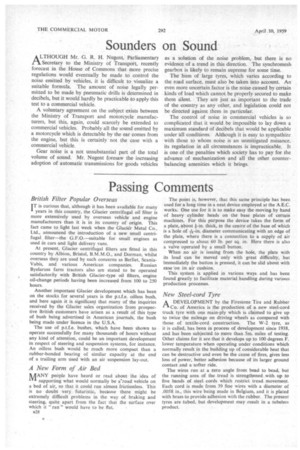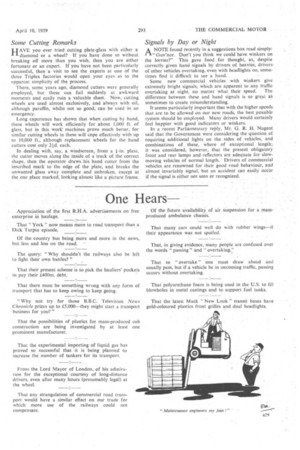Passing Comments
Page 34

Page 35

If you've noticed an error in this article please click here to report it so we can fix it.
British Filter Popular Overseas
IT is curious that, although it has been available for many 1 years in this country, the Glacier centrifugal oil filter is more extensively used by overseas vehicle and engine manufacturers than it is in its country of origin. This fact came to light last week when the Glacier Metal Co., Ltd., announced the introduction of a new small centrifugal filter—the G.F.O.—suitable for small engines as used in cars and light delivery vans.
At present, Glacier centrifugal filters are fitted in this country by Albion, Bristol, B.M.M.O., and Dorman, whilst overseas they are used by such concerns as Berliet, ScaniaVabis, and various American companies. Russian Byelaruss farm tractors also are stated to be operated satisfactorily with British Glacier-type oil filters, engine oil-change periods having been increased from 100 to 250 hours.
Another important Glacier development which has been on the stocks for several years is the p.t.f.e. oilless bush, and here again it is significant that many of the inquiries received by the Glacier sales organization from prospective British customers have arisen as a result of this type of bush being advertised in American journals, the bush being made under licence in the U.S.A.
The use of p.t.f.e. bushes, which have been shown to operate successfully for many thousands of hours without any kind of attention, could be an important development in respect of steering and suspension systems, for instance. An oilless bush would be much more compact than a rubber-bonded bearing of similar capacity at the end of a trailing arm used with an air suspension lay-out.
A New Form of Air Bed
MANY people have heard or read about the idea of tYl supporting what would normally be a-road vehicle on a bed of air, so that it could run almost frictionless. This is no doubt very futuristic, because there might be extremely difficult problems in the way of braking and steering, quite apart from the fact that the surface over which it " ran " would have to be flat.
a28 The point is, however, that this same principle has been used for a long time in a neat device employed at the A.E.C. works. One use for it is to make easy the moving by hand of heavy cylinder heads on the base plates of certain machines. For this purpose the device takes the form of a plate, about fin. thick, in the centre of the base of which is a hole of *-in. diameter communicating with an edge of the plate, where there is a connection to a supply of air compressed to about 60 lb. per sq. in. Here there is also a valve operated by a small button.
When no air is issuing from the hole, the plate with its load can be moved only with great difficulty, but immediately the button is pressed, it can be slid about with ease on its air cushion.
This system is applied in various ways and has been found greatly to facilitate material handling during various production processes.
New Steel-cord Tyre
A DEVELOPMENT by the Firestone Tire and Rubber
of America is the production of a new steel-cord truck tyre with one main-ply which is claimed to give up to twice the mileage on driving wheels as compared with those of textile-cord construction. The W-2 tyre, as it is called, has been in process of development since 1938, and has been subjected to more than 5m. miles of testing. Other claims for it are that it develops up to 100 degrees F. lower temperature when operating under conditions which normally result in the building up of considerable heat that can be destructive and even be the cause of fires, gives less loss of power, better adhesion because of its larger ground contact and a softer ride.
The wires run at a zero angle from bead to bead, but the running area of the tread is strengthened with up to five bands of steel cords which restrict tread movement. Each cord is made from 39 fine wires with a diameter of .0058 in., this wire being made in Belgium, and it is plated with brass to provide adhesion with the rubber. The present tyres are tubed, but development may result in a tubeless product.
Some Cutting Remarks
HAVE you ever tried cutting plate-glass with either a -i• diamond or a wheel? If you haVe done so without breaking off more than you wish, then you are either fortunate or an expert. If you have not been particularly successful, then a visit to see the experts at one of the three Triplex factories would open your eyes as to the apparent simplicity of the process..
There, some years ago, diamond cutters were generally employed, but these can fail suddenly at awkward moments and easily ruin a valuable sheet. Now, cutting wheels are used almost exclusively, and always with oil, although paraffin, whilst not so good, can be used in an emergency. Long experience has shown that when cutting by hand, these wheels will work efficiently for about 1,000 ft. of glass, but in this work machines prove much better, for similar cutting wheels in these will cope effectively with up to 10,000 ft,, although replacement wheels for the hand cutters cost only 21d. each.
In dealing with, say, a windscreen, from a +-in. plate, the cutter moves along the inside of a track of the correct shape, then the operator draws, his hand cutter from the inscribed mark to the edge of the plate, and breaks the unwanted glass away complete and unbroken, except at the one place marked, looking ,alrnost like a picture frame.
Signals by Day or Night.
AA NOTE found recently in a suggestions box read simply: Guv'nor. Don't you think We could have winkers on the lorries?" This ,gave food for thought, as, despite correctly given hand signals by drivers of heavies, driversof other vehicles overtaking, even with headlights on, sometimes find it difficult to see a hand.
Some new commercial vehicles with winlcers give extremely bright signals, .Which are apparent to any traffic overtaking at night,' no matter, what their speed. • The difference between these and hand signals is so great i§ sometimes to create misunderstanding.
It seems particularly important that with the higher speeds that are to be allowed on our new roads, the best possible system should be employed. Many drivers would certainly feel happier with good indicators or winkers.
In a recent Parliamentary 'reply, Mr. G. R. H. Nugent said that the Government were considering the question of requiring additional lights on the sides of vehicles, and combinations of . these, where of exceptional length; it was considered, however, that the present obligator' front and rear lamps and reflectors are adequate for slowmoving vehicles of normal length. Drivers of Commercial vehicles are renowned for their good toad. behaviour, and almost invariably signal but an accident can easily occur if the signal is either not seen Or recognized.












































































































